Questions of economy: is it rational to use electric convectors for heating a private house?
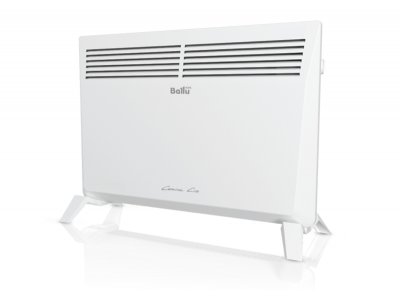
Heating of a private house is carried out in several different ways, including: is gaining more and more popularity heating with an electric convector.
It represents a structure in the form of a flat metal rectangle, the middle of which is filled with a coil that heats the air.
The upper and lower parts of the convector are equipped with narrow openings for the intake of cold air and the release of hot air. When the device is switched on, convection - mixing of air layers and uniform distribution of heat in the room.
Content
Advantages of electric convectors in a country house or cottage
Heating of a private house is carried out by means of two systems:
- Circulating carrier designs, which requires connecting a lot of equipment: a boiler for heating, a special pump for forced circulation of liquid in the system and an expansion tank. Pipes and modern radiators are also required.
- By using electrical appliances ― convector, fan heater and air heater.
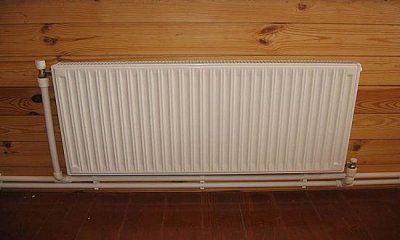
Using an electrical appliance in a private home provides a number of advantages:
- Lack of preparation process. To install the device, simply secure it yourself (depending on the type) and connect it to electricity. No additional permits or documentation are required.
- Availability. The connection is done by yourself, without specialists with professional skills.
- Ease of maintenance. Maintenance of the device consists of wiping off dust, without separate cleaning of air ducts and calling in adjusters. The manufacturer's declared operation of the product is 20-25 years old.
- Low cost. Compared to other systems and the purchase of the equipment required for them, this heater has the lowest price.
- Oxygen preservation. The device does not burn oxygen, which means it does not lead to dry air due to the low surface temperature.
- Temperature control accuracy. Highly sensitive automation allows you to set the mode up to 0.1°C.
- Silent operation. Convectors do not have fans or other elements that create noise effects with their movement. When choosing a model with an electronic programmer, there are not even clicks from mechanical switches.
- Efficiency 95%Electrical energy is converted into thermal energy with minimal losses, which provides the device with economic benefits.
- Low inertia. The room heating begins 30 seconds after switching on devices. Heat is supplied directly to the room, bypassing the heating of intermediate heat carriers (water or oil).
Flaws
Despite all the advantages, electric convectors have their disadvantages:
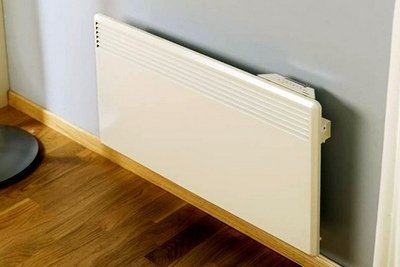
- The amount of energy consumed. The following factors influence the high indicator: outside air temperature, desired indoor heat, building insulation, presence of plastic windows.
- Availability of powerful wiring. When used simultaneously two convectors or convectors with other household appliances, weak wires may not withstand the load and burn out.
- Inefficient operation in homes with high ceilings. The heat heated by the convector accumulates under the ceiling, which is an inappropriate process, since the rest of the space remains unheated.
- Ineffective work in ventilated areas. All the warm air is simply drawn out through the ventilation holes, leaving cold air masses in the room.
Attention! At natural The ventilation convector is very effective.
Device
The design features of the convector are divided into three categories:
- Form: rectangular, square or round. However, this does not affect the work process in any way.
- Height, the speed of heated air supply to the room depends on it. The most effective is considered to be the height ― 50 cm.
- Thickness, the thicker the convector, the higher the heat transfer and, accordingly, the overall efficiency indicator.
Heating element
Inside the metal body of the convector there is a heating element, which is released three types:
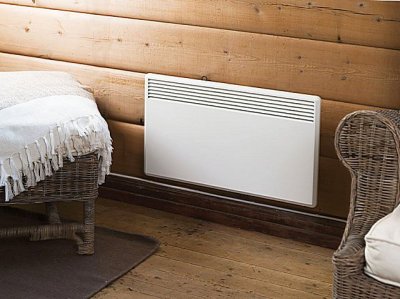
- NeedleThis type of heater consists of a plate with a nickel thread, which, due to its fragility, is short-lived.
The only advantage is the simplicity of the design and low cost.
- Tubular. The heating element can be spiral, serpentine or spring-shaped. At a low cost, such a system is trustworthy and fully justifies the small noise at the beginning of the convector's operation, when the tubes, heating up, crackle slightly.
- Monolithic. This option is the most reliable of all, but it is also the most expensive. in the first place.
Temperature regulator
Each convector is equipped with a temperature controller. It is designed to set the desired mode, which will be stable throughout the entire operation of the convector.
There are regulators two types:
- Mechanical, which allow for temperature error within 1-3 degrees. However, such regulators operate very stably with sudden voltage changes.
- ElectronicSuch devices work very clearly, with an error of tenths of a degree, however, voltage surges are critical for them.
Additional devices
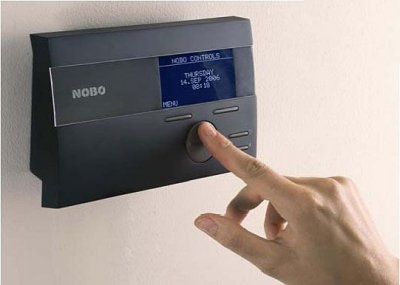
Several convectors can be controlled simultaneously using special module.
The temperature mode of each convector is set separately using the remote control on the programmer.
For example, there will be completely different modes for the nursery and the basement, which are set using special transceivers, fixed on each convector.
Operating principle
The whole process is that cold air below, penetrating through the grate, comes into contact with the heating element, as a result of which it's getting warm And, rising up from the device, heats the room.
Reference! Some convectors are equipped with fansThis design allows warm air to be dispersed around the room much faster.
Types of convectors for heating a private house
There are four main types of electric convectors on the market:
- wall-mounted;
- skirting board models;
- high;
- floor-standing and underfloor.
Wall mounted
Such mechanisms are mounted on the wall using special brackets. They are very convenient in small rooms where every meter is worth its weight in gold.
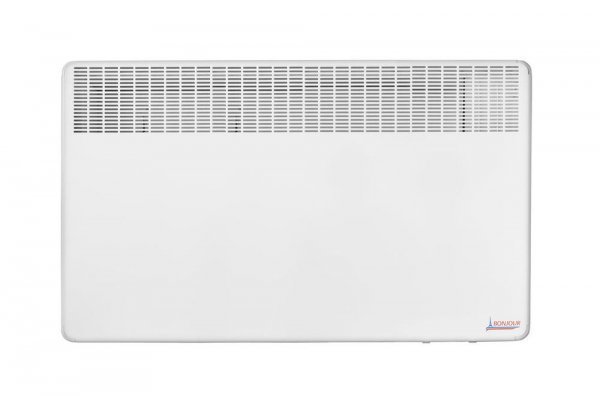
Photo 1. Electric wall-mounted convector model Atlantic, 2000 W with mechanical control, manufacturer - "Bonjour".
A type of installation is their floor modificationThe difference is in the special legs that are included with the purchase of the product.
Important! For wall-mounted convectors sensor missing, which, if random, fall, completely turns off the device.
Skirting board models
The convector is a narrow structure that is installed along the bottom line of the walls in the room. It is capable of maintaining a comfortable temperature, distributing it evenly over the entire area, without overheating the body itself, and, accordingly, the objects located near it.
Tall
The advantage of the tall model sizes is that it can be installed in any corner of the room, regardless of the rearrangement of furniture.
Floor and underfloor
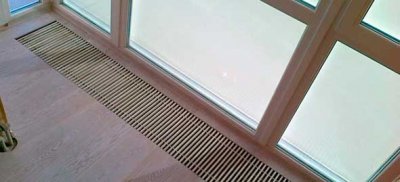
The underfloor design allows heat a room with panoramic windows, where the installation of classic water radiators is not possible.
Underfloor heating systems are installed in a special niche - a concrete screed or a wooden podium and connected to the 230V network.
Forming thermal curtain prevents condensation from appearing on the windows of the room, and the strength of the structure allows you to safely walk along the convector grille, enjoying the view from the window.
Important! Premises, exceeding 20 sq. m.., it is recommended to equip with convectors with forced convection.
Conditions of economical use
To avoid overpaying for electricity, follow these recommendations:
- install regulator so that the air simply heats up and does not overheat;
- insulate the room — install metal-plastic windows and a modern door;
- use a convector, with the most appropriate power for this room.
Main selection parameters
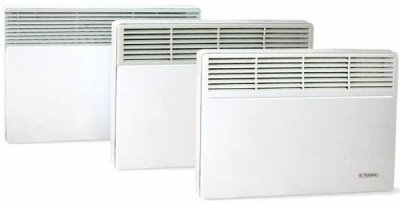
To choose a quality device, you should pay attention to the case - it is better to buy made of stainless steel.
The noise level will also be an important factor.
The main criterion is that it is suitable for the room power.
In moderate climate conditions, for heating 1 m3 need to:
- 20 W — with high-quality thermal insulation, according to European standards;
- 30 W — with installed double-glazed windows and insulated walls;
- 40 W — with double-glazed windows installed, but without wall insulation;
- 50 W - with poor thermal insulation.
Work safety
The device was originally designed for autonomous operation. When the device overheats, a special sensor automatically switches off the equipment. The main condition is powerful electrical wiring in the house, completely eliminating the risk of fire.
Special models can be installed in different rooms - in a bathroom with high humidity and in a child's room, where the model comes with rounded edges and low heating temperature of the iron bodyto avoid skin burns.
Useful video
Check out the video reviewing the electric convector from the manufacturer "Irit".
Conclusion
Summing up results on the choice of electric convector:
- The choice of model should be based primarily on required power device.
- Heating element tubular or monolithic.
- For small spaces, choose wall-mounted devices.







